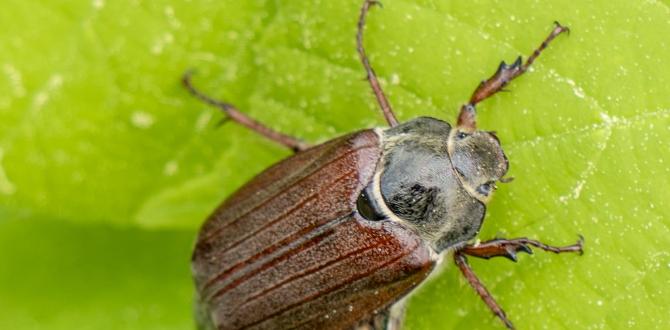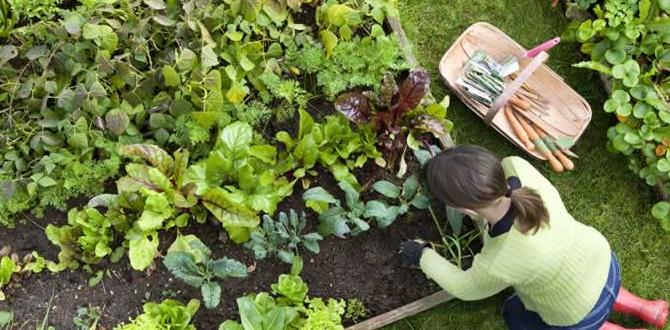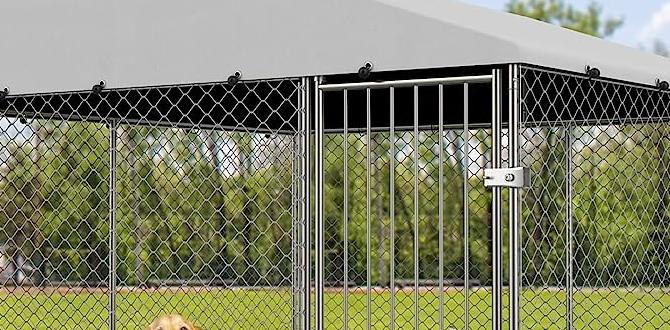Have you ever wandered through your garden and spotted shiny, green June bugs? These insects can catch your eye with their bright colors and clumsy flying. But are June bugs bad for gardens? Many people wonder if they should be worried about these little critters.
Imagine enjoying a sunny day in your garden, only to see June bugs munching on your beloved plants. You might ask yourself: “Are they friend or foe?” It’s a fair question! A fun fact to consider is that these bugs are most active during the summer months. This is when they can cause a real stir in your backyard.
In this article, we will explore the role of June bugs in gardens. Do they help or hurt your plants? Get ready to uncover some surprises about these garden visitors!
Are June Bugs Bad For Gardens? Understanding Their Impact
Are June Bugs Bad for Gardens?
June bugs can be a gardener’s unwelcome guests. They often feast on leaves, which can harm plants. However, they mostly come around at night, making them tricky to spot. Did you know that some people find their shiny bodies fascinating? Most gardens can bounce back, but keeping an eye on them is smart. You might wonder, should you worry about June bugs? Understanding their habits helps you protect your plants better.Understanding June Bugs
Description of June Bugs and their life cycle. Common species of June Bugs and their distribution.
June bugs are beetles with shiny, greenish-brown bodies. They come out mostly in late spring and early summer. These bugs go through four stages in their life cycle: egg, larva, pupa, and adult. They lay eggs in the soil. The larva, known as grubs, feed on roots and can harm plants. Common species include the Phyllophaga and Cotinis nitida, found across North America.
Are June bugs harmful to gardens?
June bugs can damage plants, especially in their larval stage. They eat roots, which can stunt plant growth or even kill them. However, adult June bugs are usually less harmful.
How June Bugs Affect Soil Health
Role of larval June Bugs in soil aeration. Potential negative effects of grubs on root systems.Larval June bugs play a surprising role in our gardens. They dig and churn the soil, creating little air pockets. This helps water and nutrients reach plant roots. Think of them as tiny gardeners! However, there’s a catch: these grubs can also munch on roots, which isn’t great for plants. Less root equals less fruit! Balance is key. Too many June bugs can turn those helpful efforts into trouble.
| Benefit | Potential Risk |
|---|---|
| Soil aeration | Root damage |
| Nutrient access | Weak plants |
Signs of June Bug Infestation
Visual indicators of their presence in gardens. How to identify damage caused by June Bugs.
Have you noticed little flying beetles munching on your plants? Those pesky June bugs might be the culprits! They love to party in gardens and can leave signs of their visit. Look for leaves with holes; it’s like they had a snack attack. If you spot brown patches on grass, June bugs could be digging up your lawn like tiny gardeners. Keep an eye out for these indicators!
| Signs of Infestation | What to Look For |
|---|---|
| Chewed Leaves | Holes and missing edges |
| Bare Patches | Dry areas in the grass |
| Brown Spots | Discolored areas in plants |
Stay alert and protect your garden guests! Remember, no one likes a surprise attack from the munching squad!
Natural Predators of June Bugs
Beneficial insects that help control June Bug populations. Encouraging wildlife to manage June Bugs naturally.Some friendly insects help keep June bug numbers down in gardens. Ladybugs, for instance, are tiny heroes that love munching on pests. Birds also play a big role, and they can snack on these beetles like candy. You can make your garden more inviting to wildlife. Plant flowers that attract insects or leave some parts messy for birds. The more nature-loving friends you have, the better! In the battle of the bugs, teamwork makes the dream work.
| Beneficial Insects | Role |
|---|---|
| Ladybugs | Eat pests like aphids |
| Praying Mantis | Catch and eat June bugs |
| Spiders | Build webs that trap bugs |
| Birds | Chirp and munch on beetles |
Effective Control Methods
Organic methods for repelling June Bugs. Chemical treatments and their impacts on garden health.
Many gardeners want to keep their plants healthy and safe from June bugs. Using organic methods like planting marigolds can help. These flowers naturally repel these pests. Spraying a mix of water and soap on your plants can also work well.
If you consider chemical treatments, remember they can harm your garden’s health. They may kill good bugs too. Try to use them carefully or explore safer options!
Are there natural ways to control June bugs?
Yes, using plants like marigolds and garlic spray can help repel June bugs.
Additional Organic Tips:
- Keep your garden clean and clear of debris.
- Encourage natural predators like birds.
- Use traps made from soapy water.
Preventive Measures for Gardeners
Best practices for maintaining a healthy garden environment. Strategies for early detection and management of June Bugs.
Keeping your garden safe from pesky June bugs can be a fun challenge! Start by maintaining a clean garden; clear away debris where bugs love to hide. Use row covers to protect delicate plants. You can spot early signs of June bugs with regular checks. Look for holes in leaves or the bugs themselves buzzing around. If you see them, hand-picking or using soap sprays works wonders. Plus, ladybugs love to munch on them—nature’s very own garden guards! Why did the June bug sit on the clock? It wanted to bug you for time!
| Best Practices | Early Detection Strategies |
|---|---|
| Keep your garden tidy | Look for damage on leaves |
| Use row covers for protection | Check for buzzing flies |
| Encourage natural predators | Inspect regularly! |
Gardening Myths: June Bugs
Common misconceptions about June Bugs and gardening. Clarifying myths versus facts regarding their impact on gardens.
Many people think June bugs are trouble for gardens. Some believe they munch on plants like they’re at an all-you-can-eat buffet. But let’s set the record straight! June bugs mainly feast on dead leaves and roots. They’re not picky eaters! In fact, they usually keep their distance from healthy plants. So, don’t grab the bug spray just yet. Instead, invite them to your garden party—just don’t serve any salad! Below is a simple breakdown of these garden myths:
| Myth | Fact |
|---|---|
| They eat garden plants. | They mostly eat decaying matter. |
| They ruin flowers. | Not true! They avoid healthy blooms. |
| They’re pests you must kill. | They can be beneficial for composting! |
Conclusion
In conclusion, June bugs can be harmful to gardens by eating plants and attracting other pests. They may damage leaves and flowers, but you can manage them. Consider using physical barriers or natural repellents to protect your garden. To learn more, check out gardening guides or talk to local experts. Together, we can keep our gardens healthy and thriving!FAQs
What Specific Damage Do June Bugs Cause To Garden Plants And Crops?June bugs can damage your garden plants and crops in a few ways. They mainly eat leaves, flowers, and fruits. This leaves holes and makes plants look bad. Sometimes, they also lay eggs in the soil, and the baby bugs eat roots. This can hurt the plants and make them weak.
How Can I Prevent June Bugs From Invading My Garden?To stop June bugs from coming into your garden, you can do a few things. First, keep your garden clean by picking up any dead leaves and debris. Second, plant flowers that smell strong, like marigolds or lavender, to keep them away. You can also use a simple trap with a bowl of soapy water to catch them. Lastly, check your plants often to spot any bugs early!
Are June Bugs Beneficial In Any Way For Garden Ecosystems?Yes, June bugs can be helpful in gardens. They help break down dead plants and leaves. This makes the soil healthier for other plants. Some animals also like to eat June bugs, which helps balance the garden. So, they can be a part of a happy garden ecosystem!
What Are Effective Methods For Controlling June Bug Populations In A Home Garden?To control June bugs in your garden, you can try a few methods. First, pick them off by hand during the evening when they are most active. You can also use traps made from soapy water in a bowl. The soapy water will catch them. Lastly, keep your garden clean by removing dead leaves and plants, which can attract them.
How Do June Bug Larvae (Grubs) Affect The Soil And Plant Health In A Garden?June bug larvae, or grubs, can hurt your garden. They eat plants’ roots, which makes the plants weak. This can cause plants to grow poorly or even die. However, grubs also break down old plants and help make nutritious soil. So, while they can be bad for some plants, they can also help the garden in other ways.
{“@context”:”https://schema.org”,”@type”: “FAQPage”,”mainEntity”:[{“@type”: “Question”,”name”: “What Specific Damage Do June Bugs Cause To Garden Plants And Crops? “,”acceptedAnswer”: {“@type”: “Answer”,”text”: “June bugs can damage your garden plants and crops in a few ways. They mainly eat leaves, flowers, and fruits. This leaves holes and makes plants look bad. Sometimes, they also lay eggs in the soil, and the baby bugs eat roots. This can hurt the plants and make them weak.”}},{“@type”: “Question”,”name”: “How Can I Prevent June Bugs From Invading My Garden? “,”acceptedAnswer”: {“@type”: “Answer”,”text”: “To stop June bugs from coming into your garden, you can do a few things. First, keep your garden clean by picking up any dead leaves and debris. Second, plant flowers that smell strong, like marigolds or lavender, to keep them away. You can also use a simple trap with a bowl of soapy water to catch them. Lastly, check your plants often to spot any bugs early!”}},{“@type”: “Question”,”name”: “Are June Bugs Beneficial In Any Way For Garden Ecosystems? “,”acceptedAnswer”: {“@type”: “Answer”,”text”: “Yes, June bugs can be helpful in gardens. They help break down dead plants and leaves. This makes the soil healthier for other plants. Some animals also like to eat June bugs, which helps balance the garden. So, they can be a part of a happy garden ecosystem!”}},{“@type”: “Question”,”name”: “What Are Effective Methods For Controlling June Bug Populations In A Home Garden? “,”acceptedAnswer”: {“@type”: “Answer”,”text”: “To control June bugs in your garden, you can try a few methods. First, pick them off by hand during the evening when they are most active. You can also use traps made from soapy water in a bowl. The soapy water will catch them. Lastly, keep your garden clean by removing dead leaves and plants, which can attract them.”}},{“@type”: “Question”,”name”: “How Do June Bug Larvae (Grubs) Affect The Soil And Plant Health In A Garden? “,”acceptedAnswer”: {“@type”: “Answer”,”text”: “June bug larvae, or grubs, can hurt your garden. They eat plants’ roots, which makes the plants weak. This can cause plants to grow poorly or even die. However, grubs also break down old plants and help make nutritious soil. So, while they can be bad for some plants, they can also help the garden in other ways.”}}]}







